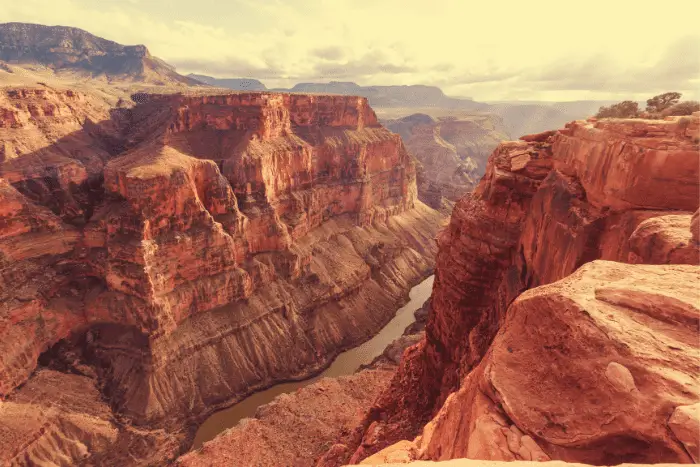The Great Smoky Mountains National Park are located between the border of Tennessee and North Carolina. The Great Smoky Mountains is the most visited National Park in the United States. The park receives more than 10 million visitors every year. Known as the smokies for always being foggy.
The national park boasts a wide array of boondocking sites. Generally, everyone loves a break from their normal life, may it be school or work. The The Great Smoky Mountains is the place you need to visit during your holiday.
There are many reasons why you should visit this place. The The Great Smoky Mountains boasts cascading waterfalls, wildlife, and views stretching out hundreds of acres. Established in 1934, The The Great Smoky Mountains boondocking sites are the ideal getaway for hiking camping and experiencing exquisite mountain ranges. This is one of the best places to visit with your family or friends, there are ample things to see and do.
Want more ideas to round-out your trip to Smoky Mountain National Park?
A lot of great ideas are in these posts!
- 13 Great Smoky Mountains Free Campsites (Updated 2022)
- OBE Great Smoky Mountains National Park Visitors Guide
- 4 Great Reasons to Visit the Smoky Mountain National Park Visitors Center
- 25 Best Hikes In Smoky Mountain National Park
- 35 Best Smoky Mountain National Park Campgrounds & RV Parks
- 19 Very Best Smoky Mountain National Park Waterfalls
- 17 Spots for Great Smoky Mountains National Park Photos
- 12 Top Things To Do In Smoky Mountain National Park
- Our 9 Favorite Smoky Mountains National Park Cabin Rentals
- 27 Best Great Smoky Mountains National Park Hotels By Entrance
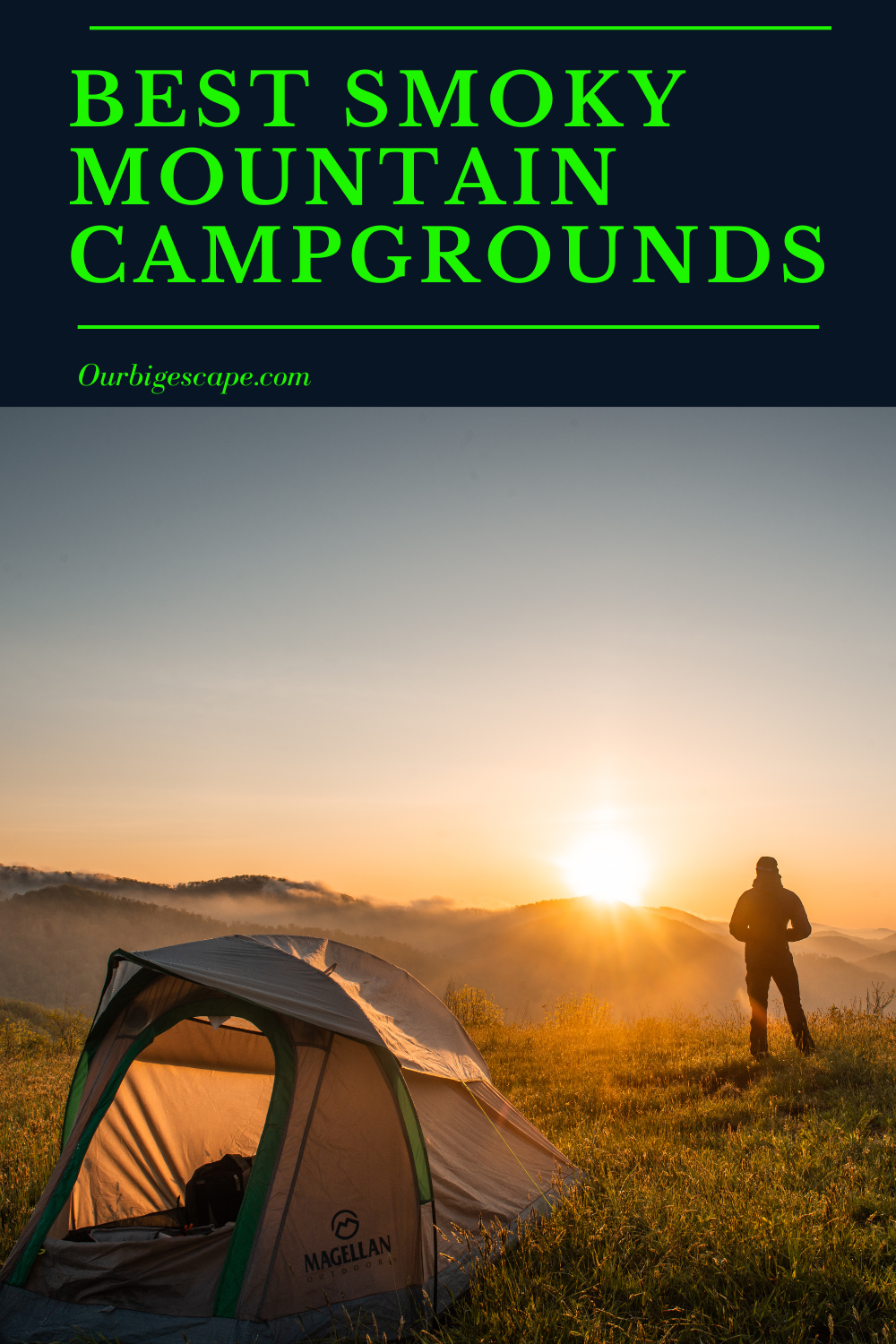
check out our video
History of the Smoky Mountains National Park
The The Great Smoky Mountains were home to indigenous people for thousands of years. It used to be the home of the historic Cherokee who lived in the various towns in the river valleys in the Appalachian mountains. The European Americans started settling here in the 18th century owing to their desire to acquire land in the deep south. in 1830 the then-president Andrew Jackson signed the Indian removal act that expelled the Indian tribes and the Cherokee from the region. The white settlers who were entrepreneurs made logging in the major industry in the mountains hence building the little river railroad to transport timber from the region. At the end of the 19th-century residents were concerned about the logging activities and started advocating for the preservation of the area. Much of the land was acquired by grassroots fundraising and the national park was officially dedicated in 1940.

13 Great Smoky Mountains National Park Free Camping and Boondocking Locations
1. The Great Smoky Mountains National Park Boondocking – Panther Creek
Address
Robbinsville, North Carolina
GPS: 35.370841, -83.627873
Elevation: 1896′
Management: Forest Service
The road in is Gravel and .5 miles from a paved road. Panther Creek is open All. There are 1-5 campsites at this location and the maximum RV length is 25 feet. You may stay 14 at Panther Creek.
Best Review:
Loved this spot by the river/creek! However, there are only two spots which were full when I got there so I ended up staying right before the bridge as well. There was a fire ring, but it was definitely not one of the actual camp sites. A sign says to only stay in designated spots (labeled by a post), but I was not hassled at all. I think the space I stayed in was actually better than the two designated spots (One a walk in and the other a large open space for a group). I wish instead of having a large open spot which just encouraged people to party there, that they would have split that into two and added a space for another person. Anyway, all were by the creek and pretty private. Spotty Verizon cell coverage the further you go back.
2. The The Great Smoky Mountains National Park Camping – Harmon Den Dispersed Camping
Address
Cold Springs Road (NFSR 148)
Hot Springs, North Carolina
GPS: 35.762689, -82.983727
Elevation: 2795′
Management: Forest Service
The road in is Gravel. You may stay 14 nights at Harmon Den Dispersed Camping. Roadside camping is generally allowed beside most gravel roads. However, along Cold Springs Road (NFSR 148) in Harmon Den, roadside camping is permitted only at sites with a camping symbol.
Best Review:
These sites are designated to minimize damage to Cold Springs Creek. At primitive camps, you must provide your own water, bury all human waste and toilet paper, and take out your trash. Use existing fire rings, and never wash in a creek.

3. The The Great Smoky Mountains National Park Boondocking – Santeetlah Lake Site #P13
Address
E. Buffalo Circle
Robbinsville, North Carolina
GPS: 35.363163, -83.831619
Elevation: 1975′
Management: Forest Service
The road in is Paved. Santeetlah Lake Site #P13 is open April to October (see comments). There are 1-5 campsites at this location. You may stay 14 Days at Santeetlah Lake Site #P13.
Best Review:
Small primitive site next to Santeetlah Lake. The site is right off the road and very small. Suitable for Tents, very small RVs. No electric, water, hook-ups and restroom. You must carry-out your own waste. Be considerate as the site is surrounded by private properties.

4. The The Great Smoky Mountains National Park Boondocking – Santeetlah Lake, Pine Ridge Road NCSR #1147
Address
Pine Ridge Road
Robbinsville, North Carolina
GPS: 35.367268, -83.853607
Elevation: 1953′
Management: Forest Service
The road in is Paved. Santeetlah Lake, Pine Ridge Road NCSR #1147 is open April to October (see comments). There are 6-15 campsites at this location and the maximum RV length is See comments. You may stay 14 Days at Santeetlah Lake, Pine Ridge Road NCSR #1147.
Best Review:
10 primitive sites along Pine Ridge Road next to Santeetlah Lake. Sites P-1, P-2, P-4, P-5, P-7, and P-8, are very small and are suitable for tents or very small RVs. Site P-3 is only suitable for tents as there is only enough parking for a small vehicle.
Site P-6 has a very small wooded loop that may be suitable for a small RV. Site P-10 and P119 have larger open loops that may be suitable for larger RV and tents (check in the area before going in as the road is very narrow) No electric, water, hook-ups. Vault toilets are available near site P-10 and P119. You must carry-out your own waste. Be considerate as the site is surrounded by private property. The view is awesome!

5. The The Great Smoky Mountains National Park Camping – Sunburst Roadside Campsites
Address
Forest Road 97
Canton, North Carolina
GPS: 35.372745, -82.937508
Elevation: 3127′
Management: Forest Service
There are 1-5 campsites at this location. You may stay 14 nights at Sunburst Roadside Campsites.
Best Review:
Ten miles from the Blue Ridge Parkway and nestled between Shining Rock and Middle Prong Wilderness within Pisgah National Forest. Two designated free campsites along the road near Sunburst Campground. Camping is only allowed in designated sites in this area. No facilities. If you need facilities, you can pay $15 and stay at nearby Sunburst Campground.

6. The The Great Smoky Mountains National Park Boondocking – Weaver Bend
Address
Del Rio, Tennessee
GPS: 35.941446, -82.929593
Elevation: 1237′
Management: Forest Service
Weaver Bend is open year round. There are 1-5 campsites at this location and the maximum RV length is 25 feet. You may stay 14 days at Weaver Bend.
Best Review:
These campsites are legit. I’m not a very experienced camper but I thoroughly enjoyed this spot. The directions are super easy to follow. At first I wasted ALOT of time trying to understand the written directions others had written, but idk if y’all just dont use google maps or what….cause if you just type Weavers Bend, Del Rio, Tn, it takes you right to it. The road you turn off to is all gravel and well maintained. It did have some low spots that we bottomed out in but we got through it just fine. (We drove up here in a 15 Camry loaded down like the Griswalds) The gravel road to the campsites is worth the drive in itself. It hugs the side of the mountain with no guard rails, so fun. It’s a few miles back, basically all the way to the end. (U can’t get lost) The designated spots have a small tent sign and are pretty easy to spot.

7. The The Great Smoky Mountains National Park Camping – Wine Spring Horse Camp
Address
Forest Road 711
Topton, North Carolina
GPS: 35.172779, -83.611694
Elevation: 4184′
Management: Forest Service
Wine Spring Horse Camp is open year-round. There are 6-15 campsites at this location. Wine Spring Horse camp is a free, primitive camping area with 6 designated camping sites. The camp area is gated with a combination lock. Reservations are required and can only be made by contacting the forest service Nantahala District Office at 828-524-6441 . Each site provides a picnic table, fire ring and tethering area for horses.
Best Review:
The Wine Spring Trail System has 15 miles of horse trails, including Wine Spring Trail #630 and Rocky Bald Trail #631 loops. Each loop is 7.5 miles long. The Wine Spring Loop crosses Goat Bald at 4800 feet elevation. Goat Bald is a large wildlife opening that offers a spectacular view to the west of the The Great Smoky Mountains and the Chilhowee Mountains in Tennessee. Some sections of the trails are located on Forest Service Roads and may have periodic administrative and logging traffic.

8. The The Great Smoky Mountains National Park Boondocking – Bear Creek Hunt Camp
Address
Robbinsville, North Carolina
GPS: 35.419874, -83.948653
Elevation: 2129′
Management: Forest Service
Free Dispersed camping in the National Forests in North Carolina’s Cheoah Ranger District. This campsite does not use a reservation system. First come, first served.
Best Review:
Drove up the forest road in the dark. We didn’t see the camp mentioned until we were leaving the next morning. GPS had some struggles on this road, becoming inaccurate. We stayed on a pull off beside the road. Quiet and solitary all night. Some vehicles drove by at 8 a.m. No Problems, good gravel road, well maintained.

9. The The Great Smoky Mountains National Park Camping – Blue Ridge Roadside Campsite
Address
Highway 215
Canton, North Carolina
GPS: 35.308069, -82.908282
Elevation: 4989′
Management: Forest Service
You may stay 14 nights at Blue Ridge Roadside Campsite. Though not directly on it, this free primitive roadside campsite was named after the Blue Ridge Parkway by the forest service.
Best Review:
On this road, highway 215, you are only allowed to camp in designated campsites. This is one of three free ones. The other two are about eight miles up the up the road near Sunburst Campground.
There isn’t a toilet, drinking water, or any trash services at this campsite. You are responsible for bringing everything you’ll need and for taking ever bit of it out with you when you leave.

10. The The Great Smoky Mountains National Park Boondocking – Investor Gap 4WD
Address
Black Balsam Knob Road
Canton, North Carolina
GPS: 35.326308, -82.880645
Elevation: 5808′
Management: Forest Service
The road in is 4×4. Investor Gap 4WD is open mid-August until January 2nd. The maximum RV length at Investor Gap 4WD is 15 feet. You may stay 14 nights at Investor Gap 4WD.
Best Review:
“If you are in a fairly capable off road vehicle there is a FS road off the parkway where you can drive into the back country a bit to camp.
Its called Investor Gap, and is up near graveyard fields. The gate for FS road 816 is open August – January. Beware as this trail is not maintained, and the last time I was up there a section of road was washed away forcing us to turn around right as DENSE fog rolled in. And its not exactly the place to be in low visibility.”

11. The The Great Smoky Mountains National Park Camping – Black Balsam Knob
Address
Canton, North Carolina
GPS: 35.3279, -82.8743
Elevation: 6207′
Management: Forest Service
Hike in tent camping is allowed on Black Balsam Knob. Fires are not permitted and bear canisters are required. Park on the road and hike 1/2 mile to get to the hill.
Best Review:
There are bare rock or grassy spots for tents (dispersed, not designated sites). The Art Loeb trail (about 4 mile loop I think) extends from here and I hear there are lots of blueberries at the top. Very scenic, as it’s at the VERY TIPPY TOP of the Blue Ridge Parkway. As you drive up the rest of the world falls away, and when you get to the top it’s very apparent. Gets very windy up there.

12. The The Great Smoky Mountains National Park Boondocking – Paint Creek Corridor
Address
35.962529,-82.867529
Greeneville, Tennessee
GPS: 35.955429, -82.883735
Elevation: 1611′
Management: Unknown
There are 1-5 campsites at this location and the maximum RV length is 25 feet. You may stay 14 days at Paint Creek Corridor. Dispersed camping along Paint Creek Corridor is permitted in designated sites only.
Best Review:
Alcoholic beverages are prohibited in the Paint Creek Corridor. From Greeneville, take TN 70 south for 11.2 miles. Turn right on Rollins Chapel Rd. and follow signs to Paint Creek Campground, then turn right onto Forest Road #41 (Paint Creek Road). From Newport, turn left on TN 107, and travel 10.1 miles. Turn right at Rollins Chapel Road and follow signs to Paint Creek Campground.

13. The The Great Smoky Mountains National Park Camping – Paint Creek Corridor 2
Address
Lower Paint Creek Rd
Greeneville, Tennessee
GPS: 35.963681, -82.866361
Elevation: 1542′
Management: Forest Service
The road in is Paved. Paint Creek Corridor is open: always, campground:4/15-11/15. There are 16-29 campsites at this location and the maximum RV length is 40-60 ft. You may stay 14 days at Paint Creek Corridor.
Best Review:
We stayed at one of the free campsites in late May, it’s pretty popular. We had a few different families camp near us. There’s an amazing swimming spot down the road with a big waterfall. There was also a nice spot to swim on the creek near the campsites. We saw a lot of fish! It was nice to have vault toilets down the road and picnic tables with grills. This campsite is great for families with kids because they will make lots of friends at the swimming hole and the campsite. Hot Springs is about 10 miles away and is a super cool little town. We checked out some other free sites next to a fishing spot (we followed fishing and camping signs to them) and those sites were totally trashed with all kinds of litter. We saw a litter crew driving around, hopefully they clean it up.

8 Great Trails to Hike at the The Great Smoky Mountains National Park
Straddling along the rugged border of Tennessee and North Carolina are the Great Smoky Mountains, one of the oldest mountain ranges in the hiking trail in the Great Smoky Mountains. As a result of its exceptional natural beauty, old-growth forests, diversity of wildlife and plant life, including more than 1500 species of flowering plants, the Smokies were designated as one of the first UNESCO World Heritage Sites in 1983.
With more than 800 miles of trails meandering throughout the park, including 71 miles of the Appalachian Trail, the Smokies are also widely recognized as one of the top hiking destinations in the east. To learn more about hiking in the Smokies and what the park has to offer.
1. Great Smoky Mountains – Mingo Falls Trail
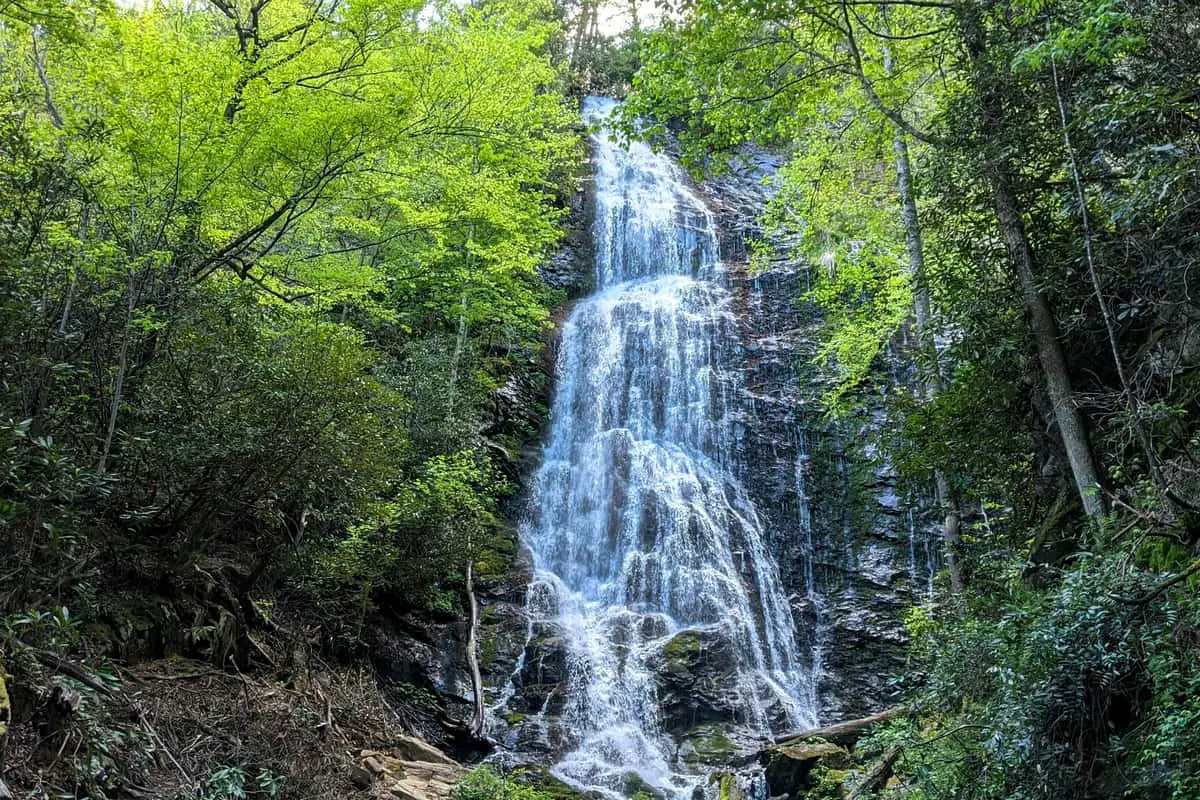
Mingo Falls Trail is a 0.3 mile heavily trafficked out and back trail located near Cherokee, North Carolina that features a waterfall and is rated as moderate. The trail is primarily used for hiking, running, and nature trips and is best used from March until November. Dogs are also able to use this trail but must
This trail is located in the boundary lands belonging to the Cherokee people right outside the park. Mingo Falls is one of the tallest waterfalls in the great mountains featuring a 120-foot drop. Mingo is Cherokee for black bear.
Length: 0.3 mi
Elevation Gain: 98 ft
Route Type: Out and Back
Dogs on leash, Kid friendly, Hiking, Nature trips, Running, Forest, River, Waterfall, Wildflowers, Wildlife

2. Great Smoky Mountains – Alum Cave Trail
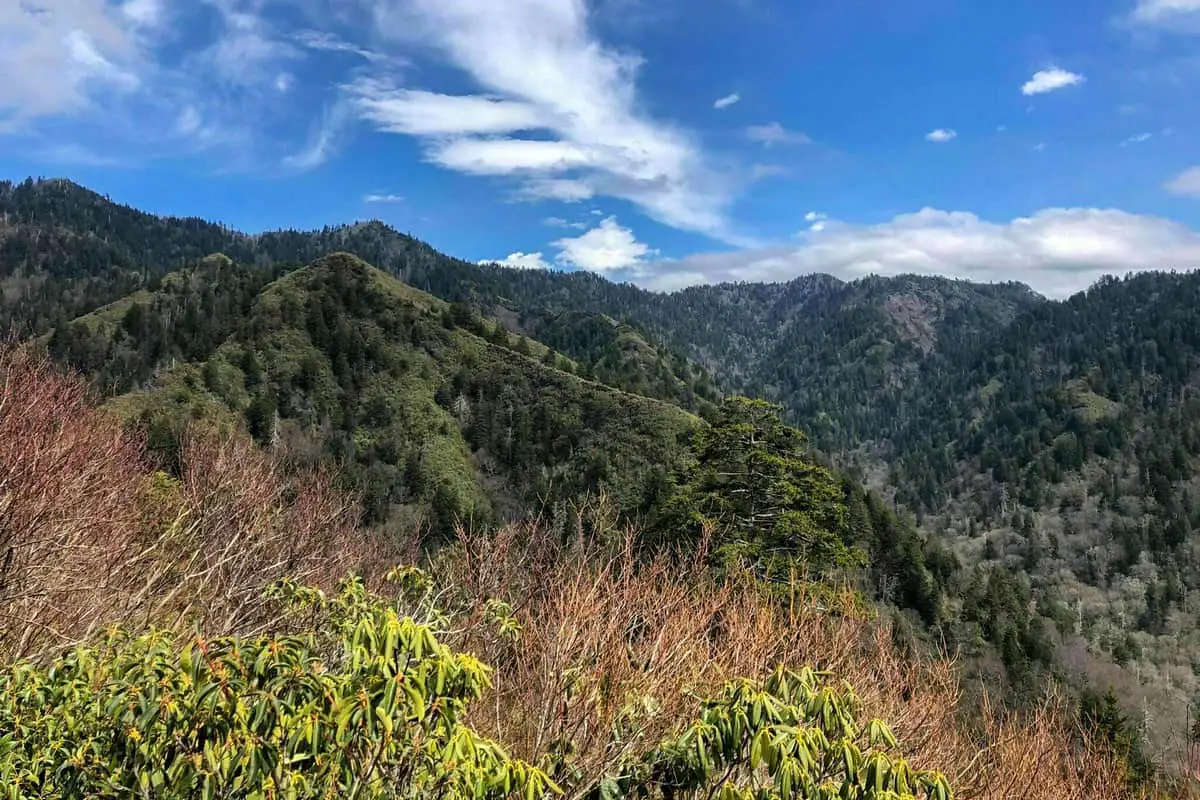
Alum Cave Trail to Mount Le Conte is a 10.9 mile heavily trafficked out and back trail located near Gatlinburg, Tennessee that features a waterfall and is rated as difficult. The trail is primarily used for hiking and backpacking and is best used from April until November.
The Alum cave trail starts by crossing the walker camp prong and log bridges on the alum cave creek which leads hikers through an old-growth forest. Walking through the narrow cave is the highlight of the trail. The aim is to reach a rocky outcrop known as the inspiration point 2 miles into the hike.
Length: 10.0 mi
Elevation Gain: 2896 ft
Route Type: Out and Back
Backpacking, Hiking, Cave, Forest, River Views, Waterfall, Wildflowers, Wildlife, Rocky, Scramble, No dogs

3. Great Smoky Mountains – Great Smoky Mountains – Rainbow Falls Trail
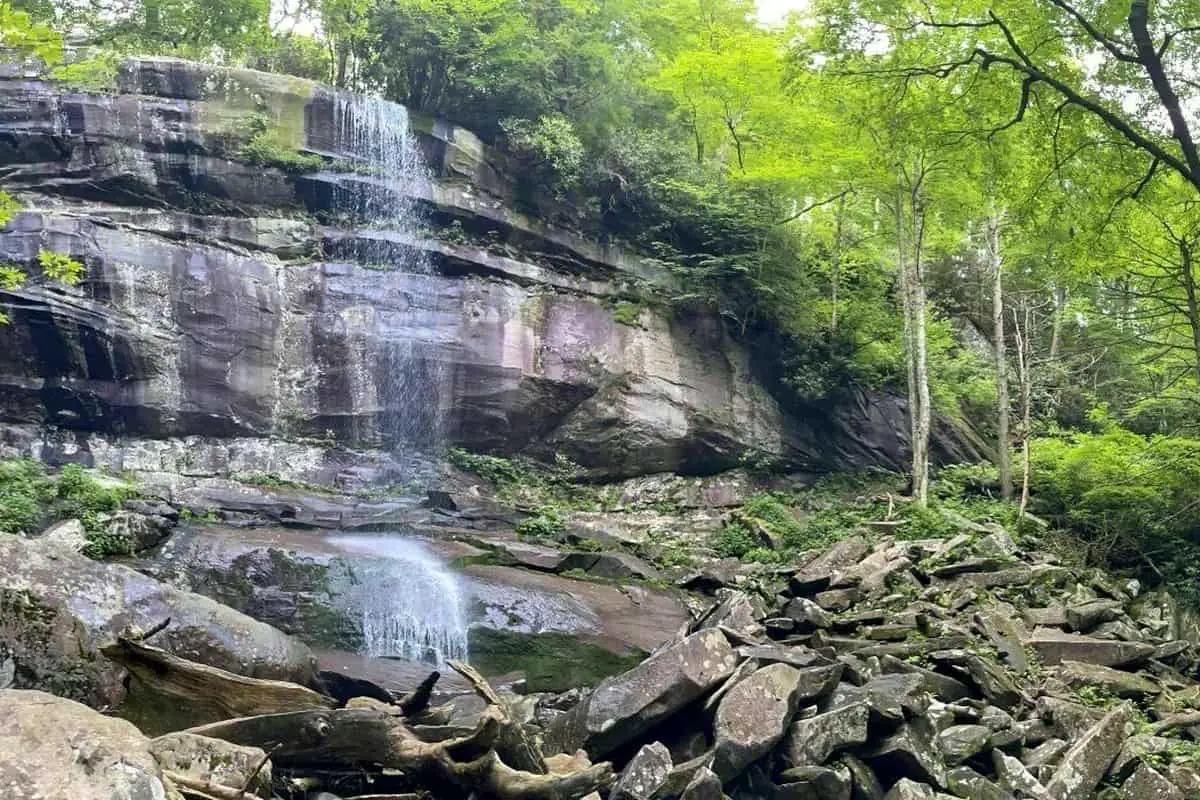
The Great Smoky Mountains Rainbow Falls Trail is a 5.1 mile heavily trafficked out and back trail located near Gatlinburg, Tennessee that features a waterfall and is rated as difficult. The trail is primarily used for hiking.
The mist from the high waterfall produces a rainbow that is visible on sunny afternoons. It does not end there as during winter months ice formations build around the falls making it a spectacular sight for the visitors. The rainbow falls trail is located in the roaring fork area. The trip around the waterfall is 5.4 miles long and considered less difficult compared to the roaring fork trail. Hiking gear is still essential as some parts of the trail are very rocky. Drinking water is also important for hydration.
Length: 5.1 mi
Elevation Gain: 1617 ft
Route Type: Out and Back
Hiking, Forest, River Views, Waterfall, Wildflowers, Wildlife, Rocky, No dogs
4. Great Smoky Mountains – Porters Creek Trail
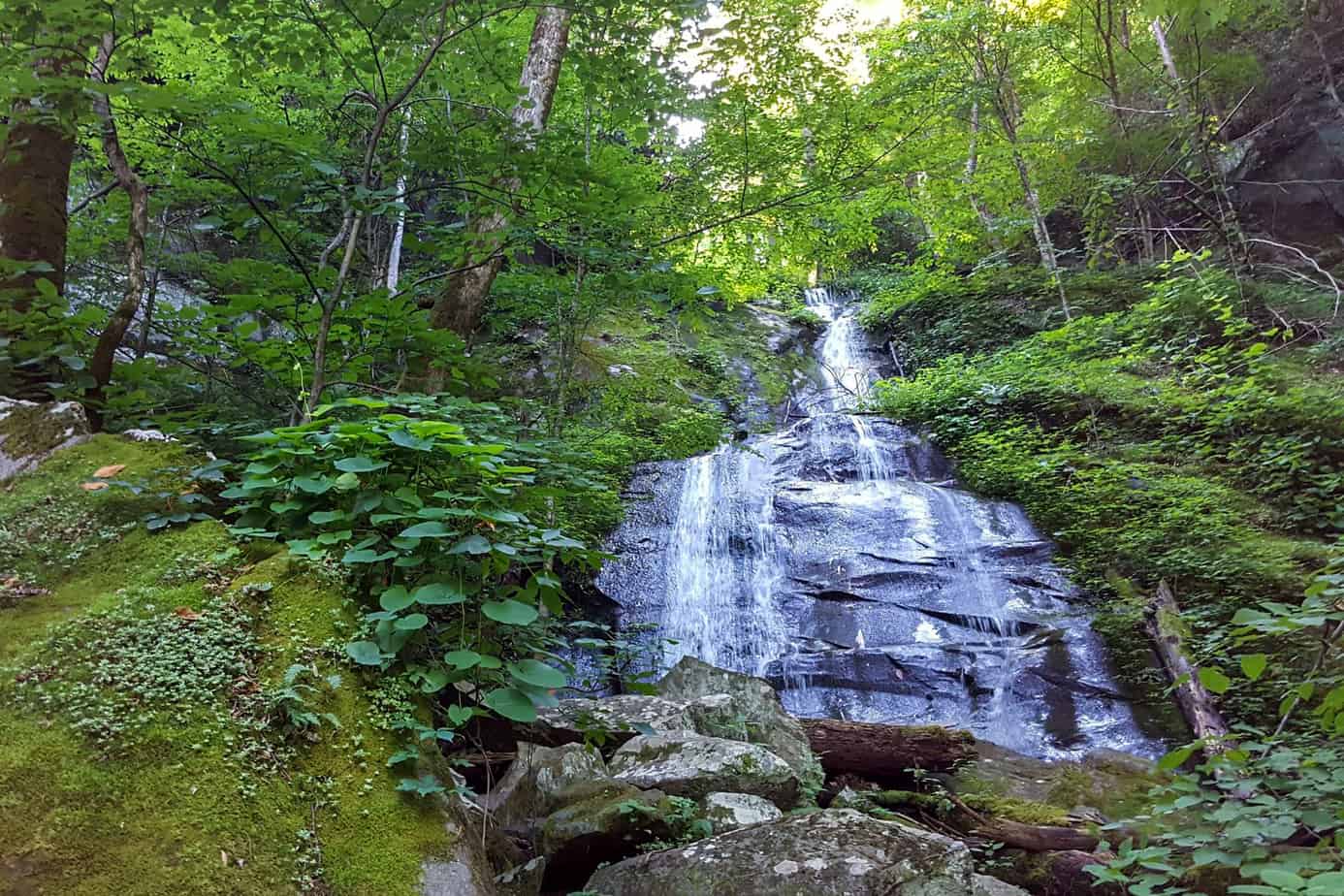
Porters Creek Trail is a 7 mile heavily trafficked out and back trail located near Gatlinburg, Tennessee that features a waterfall and is rated as moderate. The trail is primarily used for hiking, camping, horses, and backpacking and is accessible year-round. Horses are also able to use this trail.
The porter’s creek trail located near Gatlinburg, Tennessee. It boasts a waterfall and is considered moderate in difficulty level when hiking. The trail also features campers and horseback riders.
Length: 7.0 mi
Elevation Gain: 1512 ft
Route Type: Out and Back
Kid friendly, Backpacking, Camping, Hiking, Horseback riding, Forest, River, Views, Waterfall, Wildflowers, Wildlife, Rocky, No dogs

5. Great Smoky Mountains – Chimney Top Trail
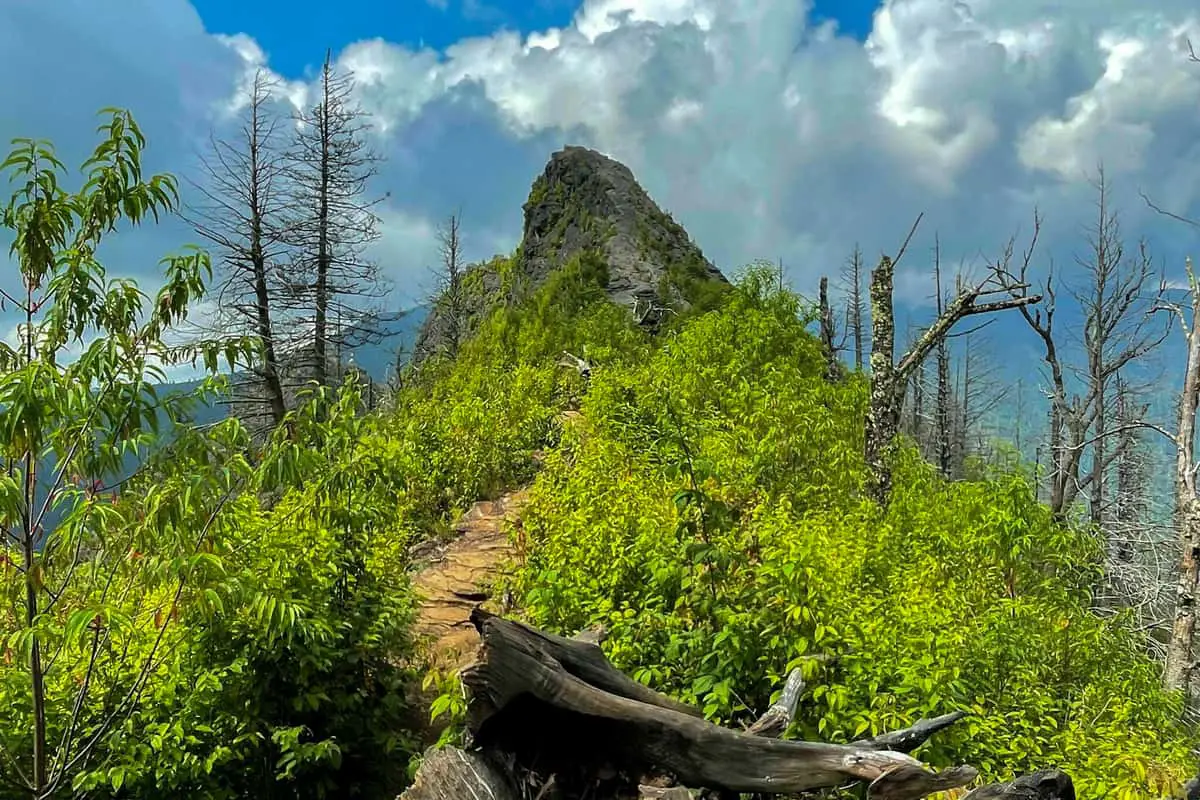
Chimney Tops Trail is a 3.6 mile heavily trafficked out and back trail located near Gatlinburg, Tennessee that features a river and is rated as difficult. The trail is primarily used for hiking and is best used from March until November.
The Chimney top trail is located at the Newfound gap road. The trail begins from the chimney top trailhead which is approximately 7 miles from the Sugarland visitors’ center that is located near Gatlinburg. The trail offers beautiful panoramic views and cascading streams.
Length: 3.6 mi
Elevation Gain: 1286 ft
Route Type: Out and Back
Hiking, Forest, River, Views, Wildflowers, Wildlife, Rocky, Scramble, No dogs

6. Great Smoky Mountains – Roaring Fork Trail
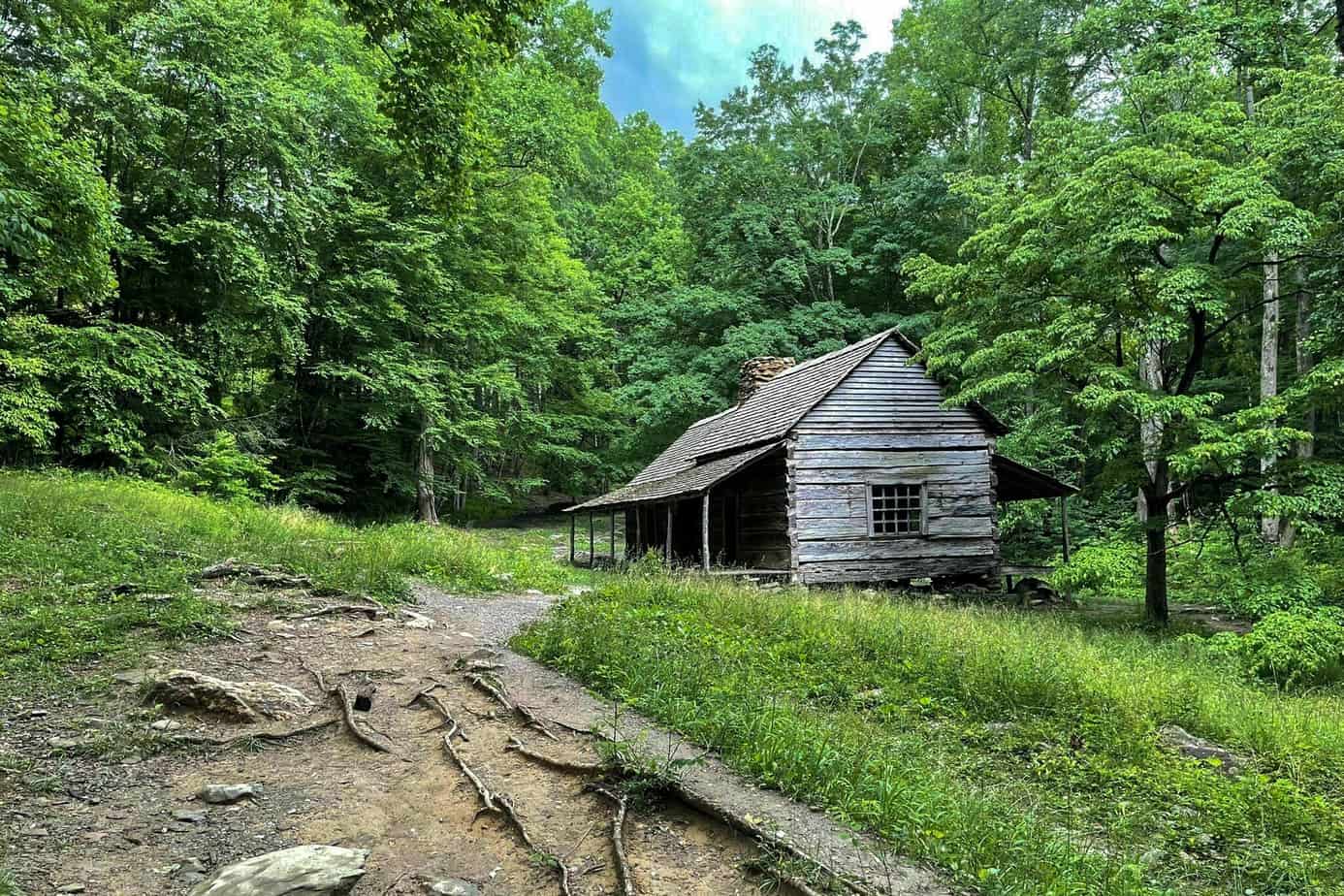
Roaring Fork Motor Nature Trail is a 6.7 mile moderately trafficked point-to-point trail located in the Great Smoky Mountains near Gatlinburg, Tennessee that features a waterfall and is good for all skill levels. The trail is primarily used for bird watching and scenic driving and is best used from May until November.
This trail is a narrow and winding trail that invites visitors to enjoy the historic buildings and forest that make the area quite the scenic drive it is revered for. This one-way road is is popular with many people visiting the park. It is awash with mountain streams and scenes of old forests. It is closed during winter due to extreme weather conditions. The Noah bud ogle self-guiding nature trail is a walking tour of the authentic mountain farmstead and surrounding forest located just before entering the roaring fork trail. To hike this steep and strenuous trail one needs hiking gear with plenty of water to keep hydrated.
Length: 6.7 mi
Elevation Gain: 1200 ft
Route Type: Point to Point
Kid friendly, Scenic driving, Bird watching, Forest, Paved, River, Views, Waterfall, Wildflowers, Wildlife, No dogs

7. Great Smoky Mountains – Trillium Gap Trail to Mount Le Conte
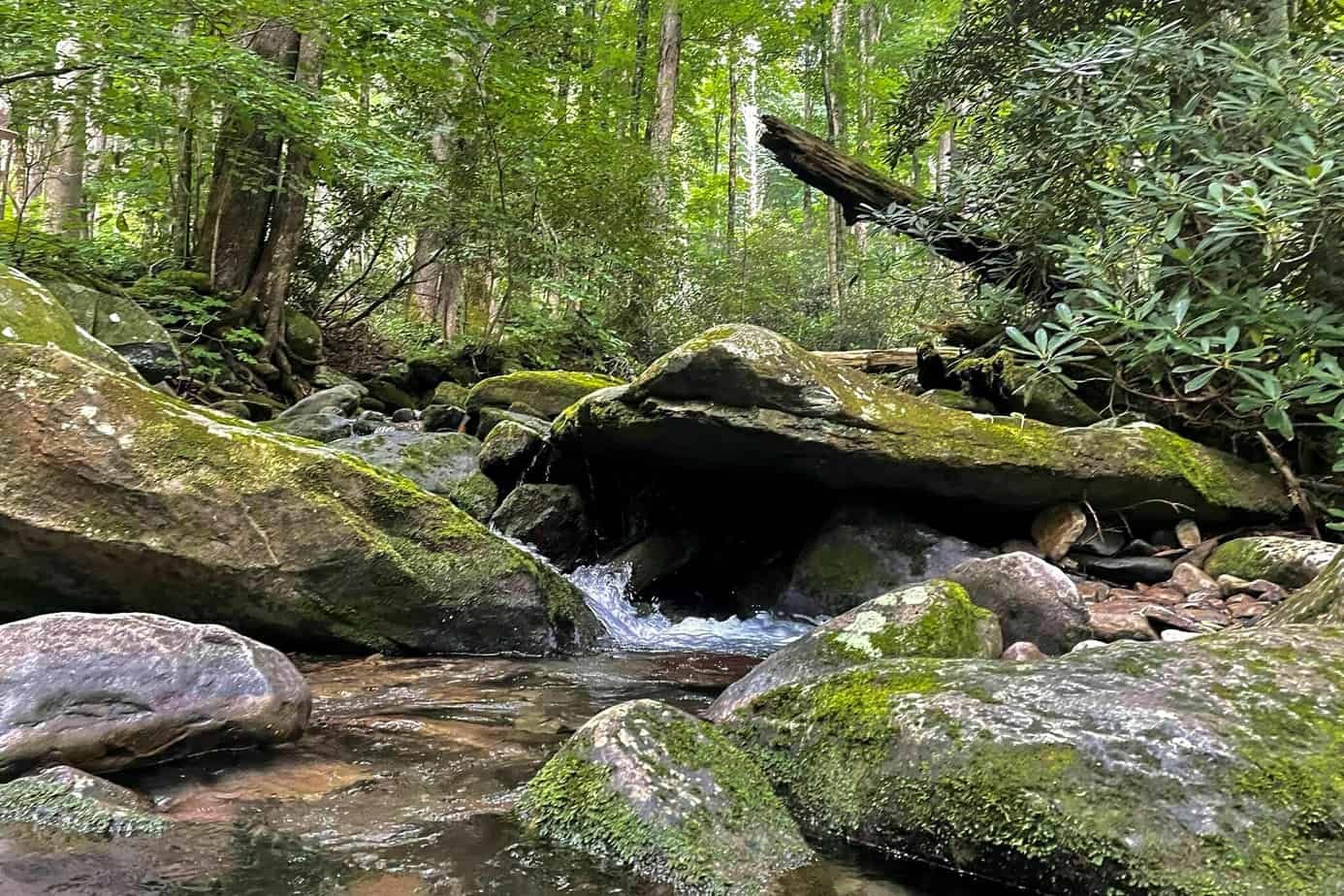
Mount LeConte via Trillium Gap Loop Trail is a 14.9 mile moderately trafficked loop trail located near Gatlinburg, Tennessee that features a waterfall and is rated as difficult. The trail is primarily used for hiking, running, camping, nature trips, and horses and is best used from March until November. Horses are also able to use this trail.
This is the third highest peak in the The Great Smoky Mountains boondocking spots and all the best in the Trillium Gap. It can be accessed by several different paths. Going around it gives you a couple of beautiful vantage points on Mount LeConte.
Length: 14.9 mi
Elevation Gain: 4022 ft
Route Type: Loop
Camping, Hiking, Horseback riding, Nature trips, Running, Forest, Views, Waterfall, Wildflowers, Wildlife, Rocky, No dogs

8. Great Smoky Mountains – Laurel FallsTrail
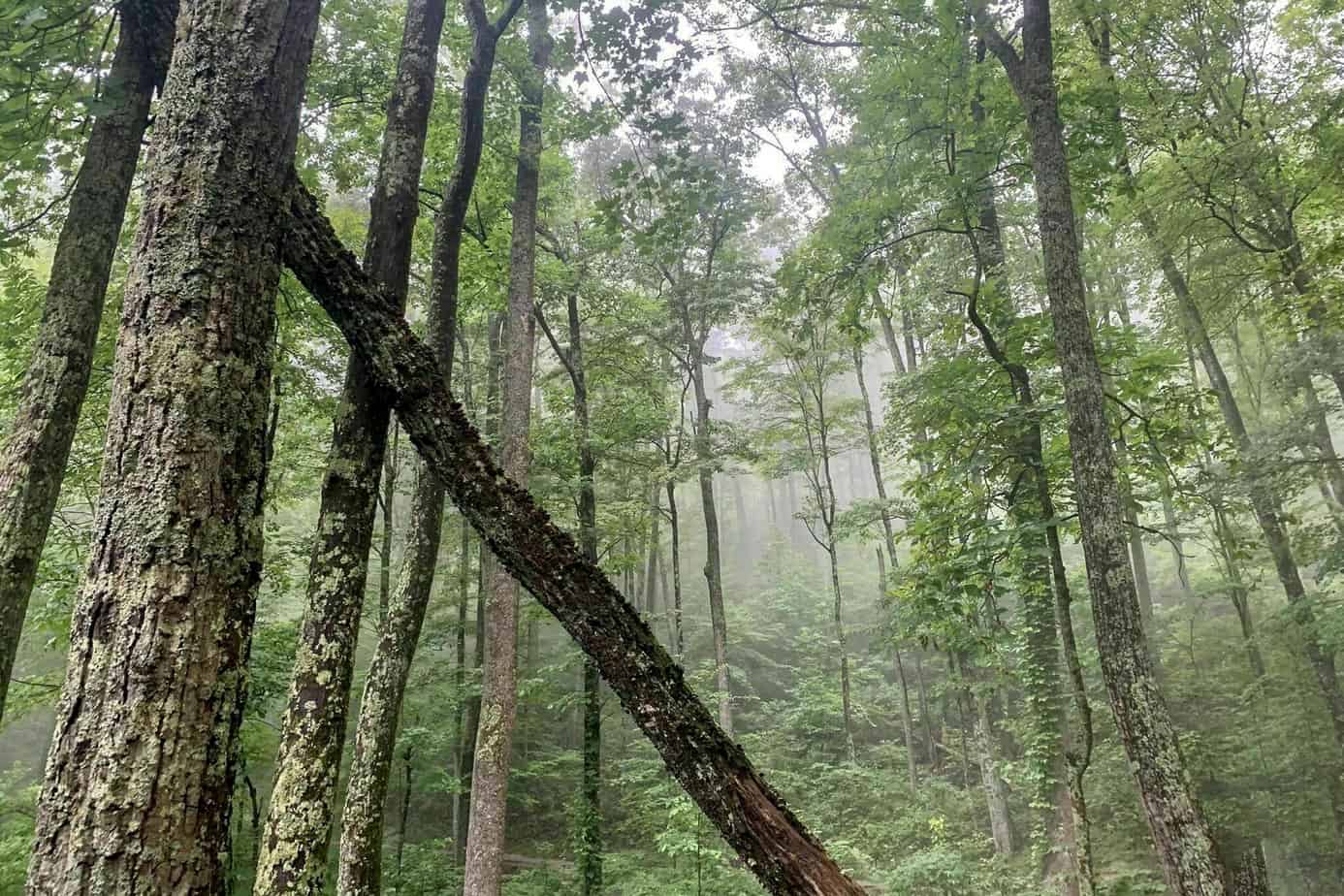
Laurel Falls is one of the most popular destinations in The Great Smoky Mountains National Park in the park and parking lot at the trailhead is limited. There is potential for parking along the sides of the road, please watch for all rules and regulations and be careful when driving amongst pedestrians.
This waterfall mimics a double-decker and falls 80 feet. It is also one of the most popular destinations in the This Great Smoky Mountains trail stretching about 2.6 miles which is also the longest paved trail in the area.
Length: 2.6 mi
Elevation Gain: 396 ft
Route Type: Out and Back
Kid friendly, Hiking, Nature trips, Walking, Forest, Paved, River, Views, Waterfall, Wildlife, No dogs

How to Get To The Great Smoky Mountains
The McGhee Tyson Airport in Knoxville, Tennessee is the closest airport in the area. It is a 30-minute drive from the park making it the most convenient. The Asheville regional airport is about an hours drive from the park and is the best option for someone wanting to visit the Maggie valley and Cataloochee
Costs and Camping For The Great Smoky Mountains National Park
Entrance to the The Great Smoky Mountains is free. It is one of the few national parks in the United States of America where entry is not charged. A rate of between $14-23 is charged per night for camping. Passes to national parks in the USA are $80 annually. People over 62 years or who receive a disability check are eligible for the senior or access pass.
7 Things to Do At the The Great Smoky Mountains
When visiting the The Great Smoky Mountains, one thing for sure is you should never leave your hiking gear. The nature trails in the The Great Smoky Mountains boondocking sites make it an irresistible activity. These are some of the things that you should include in your to-do list when visiting the national park.
1. Climb Clingman’s Dome
This round-6,643-foot peak sits at the top of the park in the state of Tennessee. It is closed from December to march and to get to the highest point you have to drive through the scenic route from Newfound Gap and walk about half a mile to the highest peak. It also boasts of a spaceship-like observation tower at the top. Skiers are also popular in the area during the winter months.
2. Paddle Fontana lake
Fontana Lake is situated along the park’s southern border and is formed by a dam on Little River. It runs 240 miles of shores that attract canoeists, kayakers, and also paddleboarders. You can pack a boat in advance or rent from the Fontana village for a day trip.
3. Autumn Leaf-peeping
In the fall the The Great Smoky Mountains are famous for colorful trees. Depending on preference you can drive or hike to the higher areas to catch a glimpse of the beautiful views over the wide array of tree species in the park that paint the hills in bright colors.
4. Drive On Historic Park Roads
The cade coves boast an eleven-mile one-way loop road that cuts across it through a valley surrounded by mountains. There are historic buildings, a grist mill, and wildlife that are worth a stop to watch.
5. Walking the Appalachian trail
The The Great Smoky Mountains are cut across by a seventy-one-mile trail known as the Appalachian Trail. Due to the vastness of the trail, most vacationers don’t hike through the entire run but pick sections that are doable during daylight.
6. Visiting the Newfound Gap
These low points in the mountain ranges are also known as notches or passes. The Newfound Gap is the lowest drivable notch in the pack and sits at 5000 feet. Visitors driving along this route seem to be always impressed by the beautiful mountain views. It also boasts quality facilities and easy access to trailheads making it one of the most revered trails in the The Great Smoky Mountains.
7. Sugarlands Visitor Center
Many visitors who have been to the national park before believe that the Sugarlands should be the first stop when visiting. the This center is an exhibition for extensive natural history and also shows a short film about the park.
13 Places and Things to Do and See with Descriptions
1. Smokemont Campground
This campground is located on the North Carolina side of the park. It has nice grassy areas for your activities coupled with beautiful mountain views. This The Great Smoky Mountains campground is open in the middle of March all through the middle of November.
2. Elkmont Campground
This is the largest and busiest campground in the The Great Smoky Mountain. It is located eight miles from Gatlinburg. The climate of the area consists of mild winters and hot/humid summers. This campsite has 200 tent sites and 20 walk-in tent sites. There are also wheelchair-accessible campsites within Elkmont.
3. Gatlinburg
Gatlinburg is the most toured campground of the The Great Smoky Mountains boondocking sites. It is hence known as the gateway to the mountain spots and the main visitor’s center. Some of the best and well-known hikes and drives are located near this campground. It is not the quietest and has amusement parks and aquariums to mix with the hikes.
4. Greenbrier Campground
The Greenbrier campground has the little pigeon river running around it providing swimmers with a private beach. Trout fishing is also offered on-site. It is also known for its cleanliness and friendly policies of all the The Great Smoky Mountains visitors.
5. Townsend
Located in the quietest region of the The Great Smoky Mountains. it is not as commercialized as Gatlinburg hence being preferred by people who loathe the noise and many activities in the busier campgrounds.
6. Imagination Mountain
It was formerly known as the The Great Smoky Mountains Jellystone camp resort. The imagination mountain is located about 20 minutes from Gatlinburg. Most of the camping sites are creek side and the camp workers will get you set up in no time. It boasts of a pool, ice cream parlor, arcade, and a pool.
7. The Great Smoky Mountains Railroad Scenic Train
This offers scenic views through the North Carolina Mountains along Nantahala and Tuckasegee rivers. Also goes through tunnels and across valleys. The trains depart from downtown Bryson city which is located near Tennessee.
8. Little Arrow Outdoor Resort
In this “wilderness resort” Rv sites, tiny homes, and tents are offered. It also offers a swimming pool and access to the river with various other organized activities included.
9. The Great Smoky Mountains Free Campgrounds
This is located in the boundaries of the national park. The downside to this is that ticket prices are very competitive and most visitors may term them as exorbitant. There are no hookups so visitors should prepare for an experience like no other.
10. The Cherokee/Great Smokies KOA
This campground is open all year round unlike most other campgrounds and offers a real camping experience. It offers a couple of amusement activities to its visitors, including pools, go-karts, snack bars, and various other facilities. The peak season offers packed recreation schedules. The Cherokee offers some of the best RV sites right next to the river.
11. Yogi In the Smokies
It is situated up the road to the KOA and offers the ultimate family camping experience. The RV sites are next to the river making them some of the best
12. Moraine Park Campground
This The Great Smoky Mountains boondocking site is located near the beaver meadows entrance, on the north side of Moraine Park. Here visitors can experience the gorgeous views of the big park and nearby mountains.
13. Big Creek Campground.
This camping resort is located in the remote part of the The Great Smoky Mountains. The campground is between the flowing waters of the big creek hence providing visitors with a very peaceful environment. The mountain scenery and occasional bear sightings add to the beauty around the campground. The campground offers 12 tents only to provide a traditional camping experience to its visitors. The campsites are priced at $17.5 a night.
How Much Time Do You Need For Your Visit
Previous visitors to the suggest that 3-4 days are enough if one has studied the map and decided on the sites to visit and ones to skip. It is also important to know exactly where to start and finish to save time when going through the various sites of the vast national park. For first-time visitors who are not very well acquainted with the enormous national park, an extra day is recommended so as not to miss out on any attractions.
Accommodations and Dining Near the The Great Smoky Mountains National Park
Accommodation and dining is a very important aspect of trip planning and should be afforded utmost importance, especially when visiting. Where you decide to sleep during a stay in this national park can influence the whole of your trip because it will affect your plan when choosing where to explore and if you will be getting enough sleep to enjoy the whole of your trip. Where you stay depends on price, reputation, and most importantly the size of your family. Every visitor to the national park has a unique situation that helps in deciding the best location through their visit. There is a wide variety of accommodation options available to various customers be it, log cabins, hotels, tents, and even RVs. There are also various stores in the The Great Smoky Mountains boondocking sites that help camping visitors shop for foodstuffs.
Best Time to Visit the The Great Smoky Mountains National Park
This depends on when one has got free time to have a holiday. Given this, the most ideal time to visit the The Great Smoky Mountains are the summer months of the year and the fall. The park has a diverse topography hence different altitudes so visitors should visit packed with all types of clothing anticipating varying temperatures in different parts of the The Great Smoky Mountains boondocking sites.
What to Pack For Your Visit To the The Great Smoky Mountains
1. Hiking gear to help with the hiking experience in the Great Smoky Mountains boondocking sites.
2. Epi Pen for people with bee allergy as wasps are especially aggressive in the fall.
3. Food to help boost energy during adventures as there are no restaurants within The Great Smoky Mountains Park.
4. A rain jacket for wet days.
5. Adequate drinking water to keep hydrated during the Great Smoky Mountains.
6. Different clothing layers for different weather changes.
7. Headlamp or spotlight to see at night.
8. Sunglasses and sun hats to help protect yourself from the sun.
9. Map.
You May Want to Join Our Boondocking Group on Facebook For More Information
You May Want to Join Our Campfire Recipes Group on Facebook For More Information
Check Out Our Pictures On Instagram – Our Big Escape.

